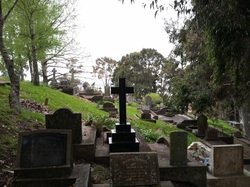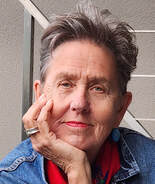Nothing makes you feel quite so alive as wandering with a dog in a cemetery on a clear spring day.
You are alive and vertical in a place where everyone else is dead and horizontal, covered in earth and lying on their backs in what remains of the boxes they were buried in. You are aware of the miracle of being alive: your heart working tirelessly in your chest, your breath, your ability to propel yourself on two strong legs, to see, to hear and to smell.

The few marble angels and doves in the cemetery have wings blunted by decades of wind and rain. Some graves are plain slabs of concrete or are covered in a riot of weeds. Some are tall obelisks. Some have headstones which are locked into cramped cages of chicken wire. Some graves are decorated with porcelain wreaths of pink roses and purple pansies, some with fake flowers and plastic windmills. Baptists, Anglicans, Presbyterians, Roman Catholics and Jews are buried in separate neighbourhoods in this city of the dead.
Conventional pieties and clichés obliterate the identity of the mourned - and the mourner. The gravestones which are most poignant are those which are either absolutely silent or those which utterly refuse to be silent. There’s a terrible poignancy in the stone which laments the death of a 20-year-old “The best of sons and dearest of brothers” or the epitaph by a husband for his “wife and soul mate” which mingles gratitude with grief. “Among my tears and heartache” it reads, “there is one thing that makes me glad - that you chose me”. There’s another kind of poignancy in the stone bearing nothing but the name “Lillian”, or the one which simply lists without comment the names of three “infant daughters”.
Walking past the graves of people born on the other side of the world in England, Germany, Scotland, Italy, Ireland, you wonder if their lives here in New Zealand were happy or if they were forever homesick. You find the grave of a young man who was born just a few days before you. Inescapably your thoughts turn, though not unpleasantly, to your own death. On a sunny spring day when you are feeling so well, you cannot really and truly believe, despite the evidence which lies before you in every direction, that one day you will be without life. And so you wonder without distress, where your body might be buried. You wonder what your epitaph might be and who will write it. You wonder if some future dog-walker in some other cemetery might pause for a moment to read it.
In the late afternoon as the light begins to fade, so too does the mood of pleasantly ruminative melancholy. Birds roosting unseen in the black, up-thrust arms of the trees twitter to each other across the shadowy paths and lurching tombstones. It is then that I some atavistic fear of the dark, of death and the dead begin to seep into me although the headlights of the cars sweeping along on Atawhai Drive are still reassuringly visible. Words like crypt and corpse and necropolis creep unbidden to mind.
I shiver, and whistle the dog who I can hear, but no longer see in the gloom. After a long moment he bounds eagerly out of the darkness with ears pricked, alert and very much alive.
 RSS Feed
RSS Feed

